20 MIN READ
Southern Soybean Diseases During Vegetative Growth
June 19, 2023
- Potential yield loss related to a disease can be minimal or dramatic depending on the disease, the environment, the time of infection, and the soybean product.
- Knowing the disease history of a field and scouting during the growing season can help when making important management decisions.
BACTERIAL DISEASES
Bacterial Blight
Identification, Characteristics, and Diagnosis
- Causal agent, Pseudomonas savastanoi pv. glycinea.
- Pathogen overwinters on residue and can be seed-transmitted.
- Pathogen spreads by wind, rain, and cultivation when plants are wet.
- Lesions can occur on above ground plant tissue, and infection of leaves in the mid to upper canopy is the most common.
- Initial symptoms appear as small, angular, water-soaked spots that turn yellow, become brown with a yellow halo around the spot, then die (Figure 1).
- Dead tissue may drop from leaves giving the leaves a tattered appearance; however, leaves usually remain attached to the plant.
- Favored by cool, wet weather. Hot, dry weather stops development.
- Infected seedlings may be stunted or die.
Management
- Plant resistant soybean products and disease-free seed.
- Rotate with non-host crops.
- Avoid cultivating when plants are wet.
- Manage residue through tillage.

Bacterial Pustule
Identification, Characteristics, and Diagnosis
- Causal agent, Xanthomonas axonopodis pv. glycines.
- Pathogen overwinters on infected soybean residue and seed.
- Spread by splashing or windblown water, and cultivation when plants are wet.
- Initial symptoms include the development of small, yellow-green lesions with higher reddish-brown centers on upper leaf surfaces (Figure 2).
- More mature lesions produce a small, slightly raised, pale-colored pustules at the center of the lesion on the underside of the leaf.
- Lesions can be small to large, irregular, and necrotic.
- Leaves can become ragged in appearance as dead tissue drops from the leaf.
- Premature defoliation may occur, which can reduce seed count and size.
- Favored by warm (86 to 92 °F) and wet weather.
Management
- Plant resistant soybean products and disease-free seed.
- Rotate with non-host crops.
- Avoid cultivating when plants are wet.
- Reduce residue through tillage.

FUNGAL DISEASES
Aerial Blight (Rhizoctonia foliar blight, Aerial web blight)
Identification, Characteristics, and Diagnosis
- Causal agent, Rhizoctonia solani.
- Overwinters as sclerotia in soil or on infested plant residue.
- Foliar symptoms usually occur on lower leaves during late vegetative growth stages.
- Initial leaf lesions appear water-soaked and grayish-green.
- Mature lesions are tan to brown (Figure 3).
- Reddish-brown lesions can develop on petioles, stems, pods, and petiole scars.
- Long strands of web-like hyphae can spread along affected tissue and small, dark brown sclerotia can form on diseased tissue.
- Favored by warm (77 to 90 °F) temperatures, high relative humidity, and wet weather.
Management
- Plant soybean products with higher tolerance ratings.
- Avoid planting soybean in previous rice fields with history of sheath blight of rice (same disease, different common name).
- Rotate with non-host crops for two years.
- Wider row widths and lower seeding rates are recommended.
- Include the application of fungicides containing a strobilurin.

Anthracnose
Identification, Characteristics, and Diagnosis
- Causal agent, Colletotrichum truncatum.
- Brown to black, irregularly shaped lesions form on stems, pods, and petioles (Figure 4).
- Premature defoliation can occur from petiole girdling.
- Infected pods may be filled with mycelium instead of seeds, or seeds may be fewer and/or smaller and can also be brown, moldy, shriveled, or normal in appearance.
- Dark spines or setae (acervuli) are visible with a hand lens within lesions.
- Leaves roll and exhibit reddening or necrosis of leaf veins.
- Infected seeds may fail to germinate.
- Infected seedlings develop dark, sunken cankers on the cotyledons, epicotyl, and radicle resulting in seedling damping off.
- Favored by warm, wet, humid conditions.
Management
- Crop rotation to non-host crops.
- Incorporation of infested residue.
- Plant disease free seed or seed treated with a recommended fungicide.
- Foliar fungicides applied after bloom can prevent seed infection. However, at the time a spray application would be most effective (R3 – R5), symptoms are not yet present.
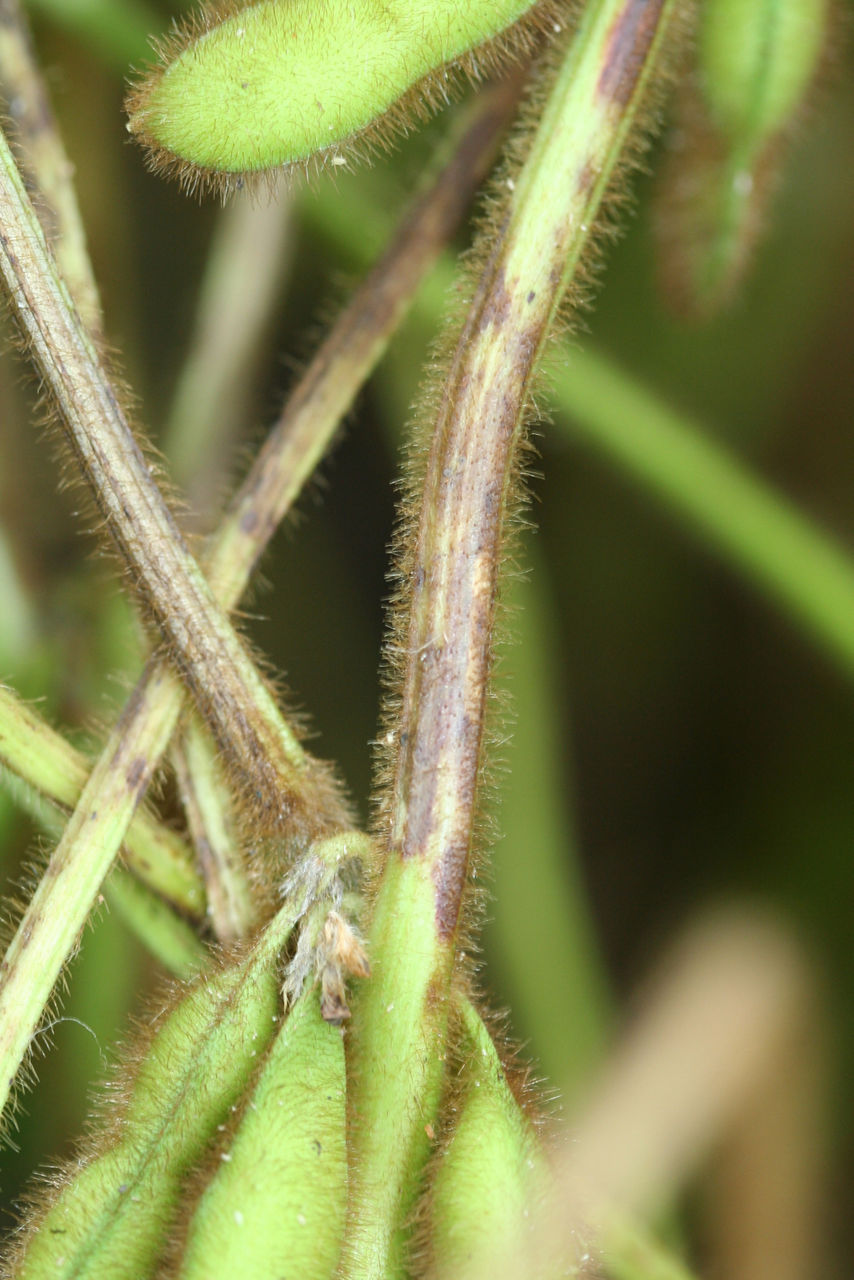
Cercospora Leaf Blight
Identification, Characteristics, and Diagnosis
- Causal agent, Cercospora kikuchii.
- Often observed during reproductive growth stages but can in early developmental stages.
- Light-to-dark purple areas develop on sun-exposed leaves and eventually cover entire leaf.
- Leaves become leathery, dark, reddish-purple, bronzed, and/or blighted (Figure 5).
- Infected pods may have a purplish discoloration.
- Fungal pathogen also causes purple seed stain.
Management
- Earlier-maturing soybean products may not be affected.
- Individual soybean products may have higher tolerance levels.
- Residue management through tillage can help reduce pathogen survivability.
- In fields with a history of the disease, a foliar fungicide containing flutriafol, tetraconazole, or difenoconazole applied at R2 to R4 may help reduce the disease.

Charcoal Rot
Identification, Characteristics, and Diagnosis
- Causal agent, Macrophomina phaseolina.
- Infection generally occurs within two to three weeks after planting when soils are wet; however, the disease becomes dormant unless hot, dry conditions occur during the growing season.
- During reproductive growth stages, developing leaves may be small, rolled, lose vigor, turn yellow, wilt, die, and remain attached to petioles.
- Infected plants may mature early and develop tiny black sclerotia that resemble charcoal powder beneath the epidermis on the lower stem, taproot, and pith (Figure 6).
- Black streaks may develop in the woody portion of the crown.
- Lower stems may appear silvery or light gray.
- Favored by light colored soils under drought conditions. Infected plants may be noted first on field edges and ridges where soil is more prone to drought.
Management
- Plant soybean products with higher levels of tolerance or resistance.
- Plant early-maturing soybean products early to reduce the potential of plants achieving reproductive growth stages during typical high heat months.
- Plant a non-host crop for one to two years to help reduce pathogen population.
- Use conservation tillage and planting methods to conserve soil moisture.
- Maintain fertility.
- Avoid high seeding rates and irrigate if possible, to help reduce stress.
- Maintain good weed control to reduce stress.
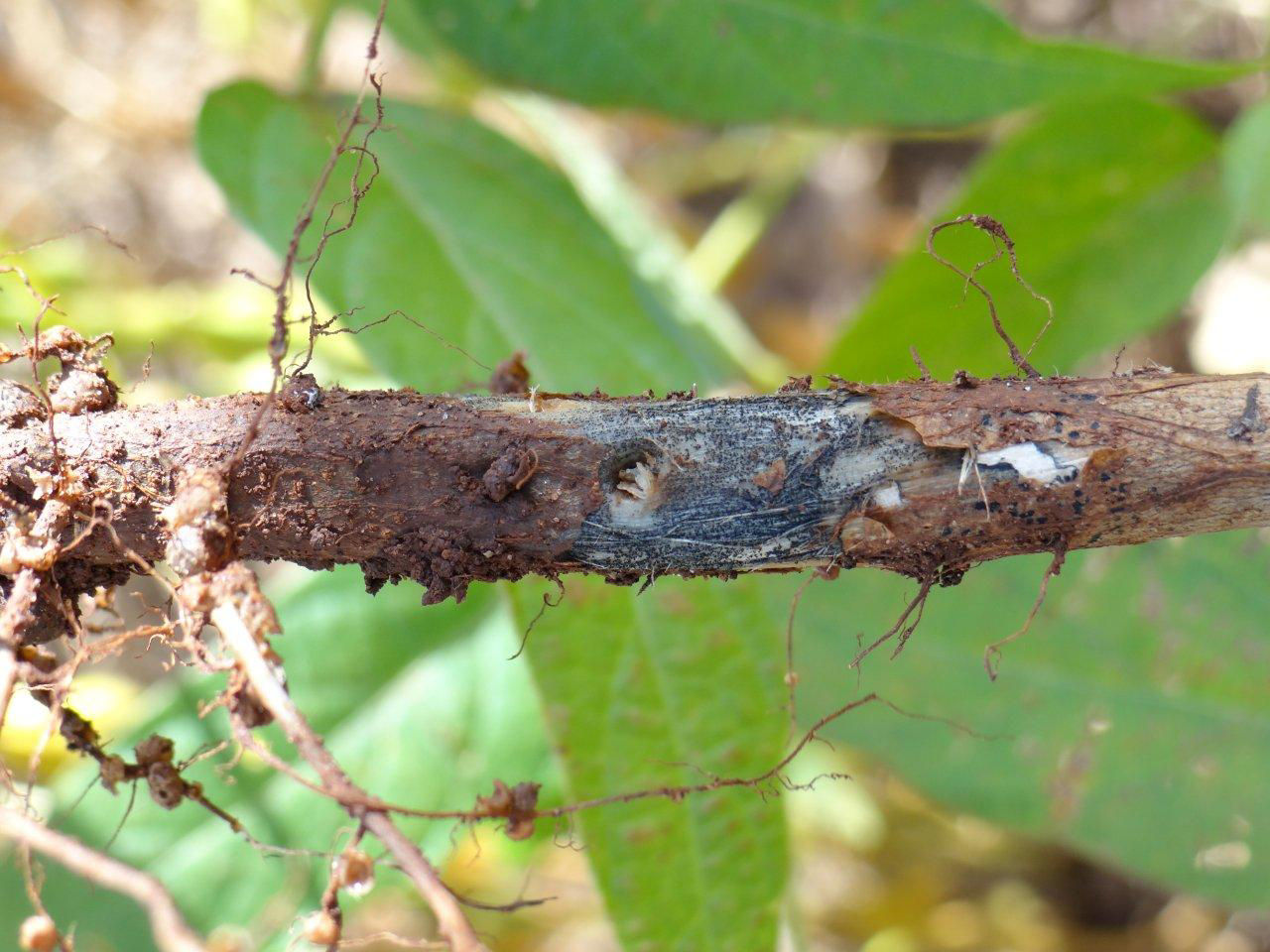
Downy Mildew
Identification, Characteristics, and Diagnosis
- Causal agent, Peronospora manshurica.
- Infection occurs in the spring when oospores germinate and infect seedlings.
- Upper surfaces of young leaves develop pale-green to light-yellow spots which enlarge into pale to bright yellow lesions (Figure 7).
- White to gray fungal tufts develop on the underside of the lesion.
- Oldest lesions become grayish-brown to dark brown with yellowish-green margins.
Management
- Plant resistant soybean products.
- Rotate with a non-host crop for one year or more.
- Foliar fungicides are not recommended as this disease rarely affects yield.
- Manage residue.
- Seed treatments can help protect seedlings from initial infection.

Frogeye Leaf Spot
Identification, Characteristics, and Diagnosis
- Causal agent, Cercospora sojina.
- Symptoms initially appear during reproductive growth stages as dark water-soaked lesions on younger leaves with centers that become ash-gray to light-brown.
- As symptoms progress, lesions become circular to angular with a purple to dark brown margin around the tan to gray center (Figure 8).
- On leaf undersides, the center of the lesions may have a dark black area where spores are produced.
- Favored by warm (77 to 86 °F) temperatures and prolonged periods of dew or light rain.
Management
- Plant resistant soybean products.
- Manage residue through tillage.
- Rotate to non-host crops for at least two years.
- Research from multiple states has indicated that fungicide applications made between R2 and R5 soybean growth stages are the most economical for control. Strobilurin fungicides belonging to the quinone outside inhibitor (QoI) group (FRAC group 11) had been effective in managing frogeye leaf spot, but some isolates of the fungus have developed resistance to the QoI fungicide group as observed in 13 states (AL, AR, DE, IL, IN, KY, LA, MO, MS, NC, OH, TN, and VA).
Septoria Brown Spot
Identification, Characteristics, and Diagnosis
- Causal agent, Septoria glycines.
- Irregular, dark brown lesions or spots that often have a surrounding yellow halo develop on lower leaves (Figure 9).
- Lesions can be small specks to 1/5 inch in diameter and coalesce to form larger spots.
- Defoliation can occur.
- Favored by wet weather and temperatures ranging from 79 to 83 °F.
Management
- Rotate to non-host crop for at least one year (avoid continuous soybean).
- Improve field drainage if possible.
- Planting later may reduce potential for saturated environment.
- In most production areas fungicide application is not recommended as the disease stops spreading with hotter, drier weather. The disease can redevelop late in the season, but often it is too late to make an economical application.
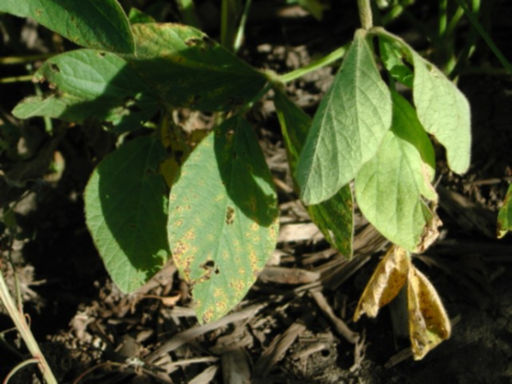
Southern Stem Canker
Identification, Characteristics, and Diagnosis
- Causal agent, Diaporthe phaseolorum var. meridionalis.
- Initial infection can occur around V3 growth stage at which point, seedlings can die quickly or survive and develop stem symptoms during pod set.
- Symptoms during reproductive growth stages appear as small reddish-brown spots on stems near a lower node.
- Spots develop into long (1 to 3 inches) cankers running up the stem from the point of infection (Figure 10).
- Cankers can girdle the plant causing plant death from interrupted nutrient and water flow.
- On dead plants, the cankers are hard to distinguish from non-infected stem tissue. Plant death can occur from a fungus-generated toxin.
- Foliar symptoms appear during reproductive stages as yellowing between the veins, usually on one side of the leaf. Leaves turn brown, die, and remain attached to the stem.
- Pith of dead stems is light brown and plants can easily snap because of brittleness.
- Favored by extended periods (24 to 96 hours) of moderate temperatures (72 to 86 °F) and wet weather.
Management
- Plant resistant soybean products.
- Rotate to a non-host crop for two years to help reduce pathogen population.
- Use tillage to help destroy infested residue.
- Fields high in soil organic matter or with high fertility are at increased risk.

Soybean Rust
Identification, Characteristics, and Diagnosis
- Causal agent, Phakopsora pachyrhizi.
- Can overwinter on alternative hosts such as kudzu.
- Spores are carried to soybean plants by wind currents.
- Initial infection may appear as small brown or brick-red dots on the upper leaf surface (Figure 11).
- Later, raised pustules (viewable with a 30X lens), resembling small volcanoes, develop in angular lesions on the underside of leaves in the center and lower canopy. The pustules release spores through a central opening.
- Optimum conditions for infection include a minimum of six hours of leaf wetness (10 to 12 hours considered very favorable) and temperatures ranging from 70 to 80 °F (infection can occur with temperatures as low as 59 °F).
Management
- If local sentinel plots indicate the presence of soybean rust, scouting should be diligent and thorough, particularly in early-planted fields, with early-maturing soybean products, or in fields with prolonged wetness, or fields with early canopy closure.
- Foliar fungicides are the only viable option for managing soybean rust, and applications should be made prior to infection or, at the latest, very soon after initial infection.
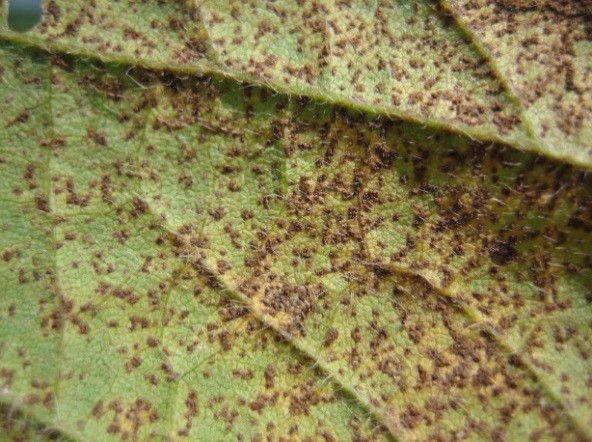
Sudden Death Syndrome (SDS)
Identification, Characteristics, and Diagnosis
- Causal agent, Fusarium virguliforme.
- Initial visual symptoms (infection usually occurs at the seedling stage) appear as small yellow spots on leaves during reproductive growth stages.
- The spots progress to interveinal chlorosis (yellowing) and eventually, the leaf tissue dies (Figure 12).
- Leaves may fall prematurely, leaving petioles attached to the stems.
- Foliar symptoms are very similar to those of brown stem rot; however, unlike brown stem rot, the roots are rotted, pith tissue remains white, and xylem (cortical tissue) is gray-to-brown.
- Under some conditions, a light blue spore masses may form on the tap root.
- The disease may be more severe in the presence of soybean cyst nematode (SCN) and in low, wet field areas.
- Favored by cool, wet conditions and may be worse following corn as the pathogen also causes stalk rot.
Management
- Plant soybean products with higher tolerance ratings. Earlier-maturing products may have a lower potential for infection.
- Include soybean seed treatments.
- Delay planting until soil conditions are drier and warmer.
- Improve field drainage, reduce soil compaction, and manage SCN.
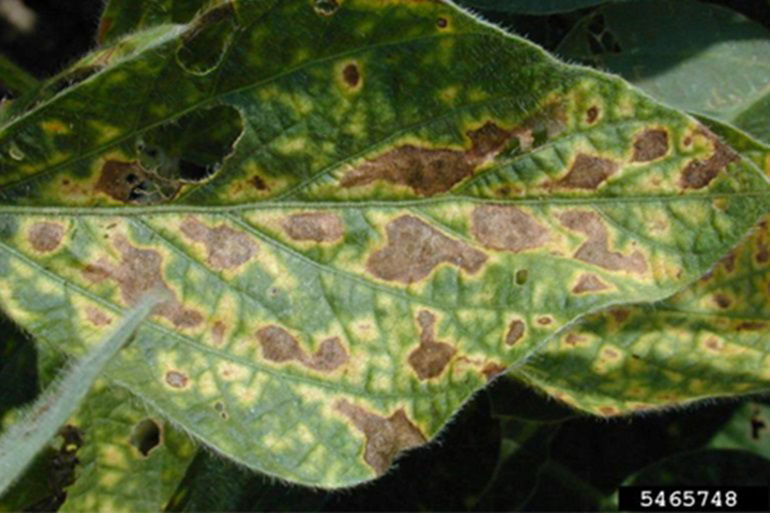
Target Leaf Spot
Identification, Characteristics, and Diagnosis
- Causal agent, Corynespora cassiicola.
- Lower leaves develop small brown specks (spots) that are round to irregular with a possible yellow halo.
- Mature spots may be 3/8 to 5/8 inches or more in diameter. Some may have a zonate appearance (Figure 13).
- Areas of infection on stems and petioles are dark brown and range from specks to elongated lesions.
- Lesions developing on pods are circular, usually small (1/32 inch), and purple or black with brown margins.
- Favored by high humidity (greater than 80%) or free moisture on plant surfaces. Dry conditions help suppress the disease.
Management
- Plant tolerant soybean products.
- Reduce surface residue through tillage.
- If possible, avoid planting back-to-back soybean crops.
- Reduce weed populations as weeds can serve as alternative hosts.
- Fungicides are not recommended because of a low potential for yield reduction.

Bean Pod Mottle
Identification, Characteristics, and Diagnosis
- Causal agent, bean pod mottle virus (BPMV)
- Vectored by the bean leaf beetle (BLB), Cerotoma trifurcate.
- Foliar symptoms range from mild chlorotic mottling on upper leaves to puckering and severe mosaic in lower leaves (Figure 14).
- Delayed maturity or green stems are often observed near harvest.
- Seed coat mottling may be present.
- Virus overwinters in bean leaf beetles and can infect seedlings as the beetles feed.
- Co-infection by BPMV and soybean mosaic virus (SMV), vectored by soybean aphid, may cause severe dwarfing, foliar distortion, leaf necrosis, leaf mottling, and severe yield loss.
Management
- Managing emerging and first-generation BLBs in the spring with timely and labeled insecticides may help reduce populations of the virus laden insects.
- Controlling alternative BPMV hosts (cowpea, other bean species, and Demodium species) can help reduce the inoculum sources.
- Delayed planting may increase early-season death of BLBs, reducing vectoring populations.

Soybean Mosaic
Identification, Characteristics, and Diagnosis
- Causal agent, soybean mosaic virus (SMV).
- Aphids are a primary vector.
- A green/yellow mosaic pattern is the most common initial symptom on leaves.
- More mature leaves may exhibit a yellow/brown mosaic pattern (Figure 15).
- Premature defoliation is common.
- Infected seeds exhibit a brown or black mottling.
- Spread from plant to plant by soybean aphid feeding.
- Co-infection by SMV and bean pod mottle virus (BPMV), vectored by bean leaf beetle, may cause severe dwarfing, foliar distortion, leaf necrosis, leaf mottling, and yield loss.
Management
- Seeds should be virus free.
- Plant resistant soybean products.
- Early planting may help minimize aphid transmission at an early crop growth stage.
- Insecticide applications are not recommended because some insecticides may increase soybean aphid movement in the field, increasing the dissemination of the virus.
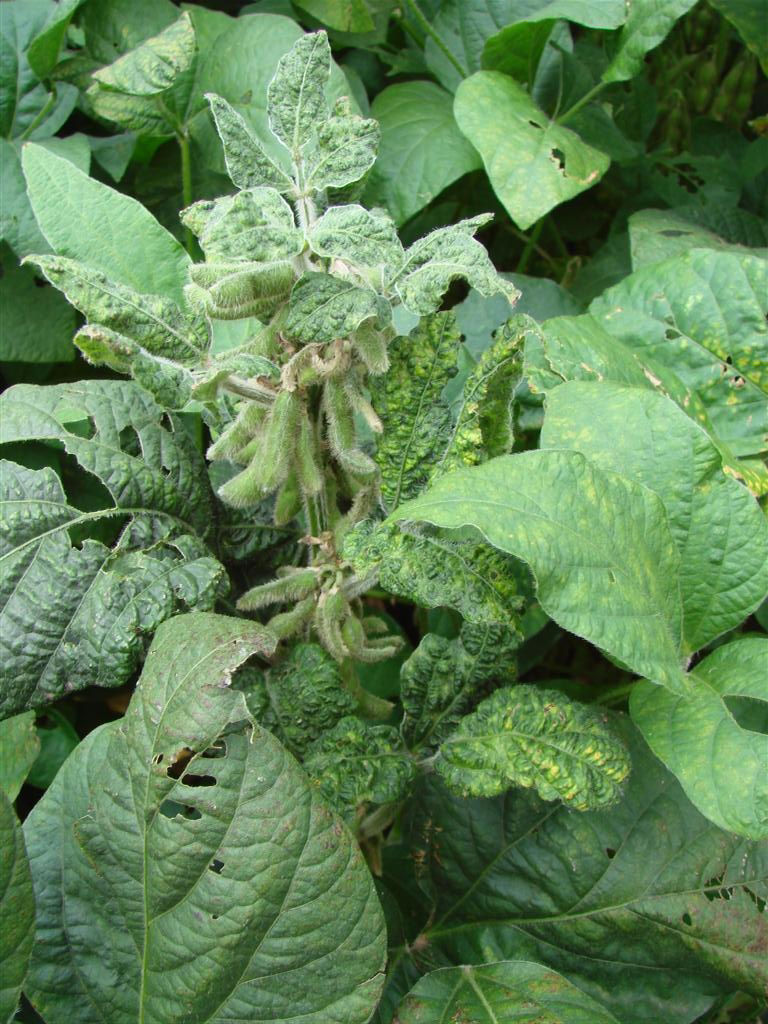
Soybean Vein Necrosis
Identification, Characteristics, and Diagnosis
- Causal agent, soybean vein necrosis virus (SVNV).
- Vectored by soybean thrips, Sericothrips variablilis, and may also be seed transmitted.
- Virus infection can occur throughout the growing season; however, symptoms are most visible after flowering.
- Initial symptoms appear as thread-shaped vein clearing along the main leaf veins; severe infections may result in purple to dark brown lesions across most of the leaf (Figure 16).
- Veins become yellow and necrotic as the growing season progresses.
- Several areas on a leaf may have lesions.
- Early lesions lack defined edges.
- Leaves highest in the canopy are most affected because emerging leaves are prime feeding sites for soybean thrips.
- Favored by cool temperatures and mild winters followed by a warm spring which may help increase thrips population.
Management
- Control soybean thrips with timely applications of labeled insecticides.
- Control of alternate virus hosts, ivy leaf morning glory, cowpea, and mung bean can help reduce inoculum sources.

Tobacco Ringspot (Bud Blight)
Identification, Characteristics, and Diagnosis
- Causal agent, tobacco ringspot virus (TRSV).
- Seed transmission is the most important means of long-distance spread, and mechanical transmission moves the virus from plant to plant within the field. Can also be vectored by dagger nematode.
- Causes reduced pod set, seed formation, and lower protein and oil content in seeds.
- Bud necrosis and excessive leaf and bud growth are the most distinctive symptoms (Figure 17).
- Leaves may be thicker and darker.
- Stems of infected plants remain green for several weeks past typically maturing plants at harvest and plant pith may become brown.
- Pods are undeveloped or aborted.
- Virus can remain viable for at least five years in embryos of stored seeds.
Management
- Control of alternate virus hosts such as Palmer amaranth and lambsquarters.
- Plant virus-free seeds.
- Select fields with minimal populations of dagger nematode.

Sources:
Faske, T., Kirkpatrick, T., Zhou, J., and Tzanetakis, I. Soybean diseases. Arkansas Soybean Production Handbook. Chapter 11. https://www.uaex.uada.edu/publications/.
Kelly, H.M. and Stewart, S. Southern stem canker. Institute of Agriculture. The University of Tennessee https://guide.utcrops.com/.
Hershman, D.E. 2013. Stem canker of soybean. Plant Pathology Fact Sheet. PPFS-AG-S-07. University of Kentucky. http://plantpathology.ca.uky.edu/.
Kelly, H.M. and Stewart, S. Charcoal rot. Institute of Agriculture. The University of Tennessee https://guide.utcrops.com/.
Hershman, D.E. 2011. Charcoal rot of soybean. Plant Pathology Fact Sheet. PPFS-AG-S-02. University of Kentucky. http://plantpathology.ca.uky.edu/.
Kelly, H.M. and Stewart, S. Frogeye leaf spot. Institute of Agriculture. The University of Tennessee https://guide.utcrops.com/.
Faske, T. 2016. Soybean disease update and management: Frogeye leaf spot. University of Arkansas. https://www.uaex.uada.edu/publications/.
Kelly, H.M. and Stewart, S. Target leaf spot. Institute of Agriculture. The University of Tennessee https://guide.utcrops.com/.
Faske, T. and Kirkpatrick, T. Target spot of soybean. University of Arkansas. https://www.uaex.uada.edu/.
Kelly, H.M. and Stewart, S. Soybean rust. Institute of Agriculture. The University of Tennessee https://guide.utcrops.com/.
Coker, C., Hurst, K., Kirkpatrick, T., Rupe, J., Tingle, C., and Trent, M. 2005. Asian soybean rust. FSA7531. Agricultural and Natural Resources. University of Arkansas. https://www.uaex.uada.edu/publications/.
Kelly, H.M. and Stewart, S. Brown spot. Institute of Agriculture. The University of Tennessee https://guide.utcrops.com/.
Faske, T. and Kirkpatrick, T. Brown spot of soybean. University of Arkansas. https://www.uaex.uada.edu/publications/.
Kelly, H.M. and Stewart, S. Cercospora leaf blight. Institute of Agriculture. The University of Tennessee https://guide.utcrops.com/.
Hershman, D.E. 2009. Cercospora leaf blight in Kentucky. Plant Pathology Fact Sheet. PPFS-AG-S-20. University of Kentucky. http://plantpathology.ca.uky.edu/.
Kelly, H.M. and Stewart, S. Sudden death syndrome. Institute of Agriculture. The University of Tennessee https://guide.utcrops.com/.
Spurlock, T. 2015. Sudden death syndrome of soybean found. Arkansas Row Crops. University of Arkansas. https://www.uaex.uada.edu/publications/.
Faske, T. and Kirkpatrick, T. Anthracnose of soybean. University of Arkansas. https://www.uaex.uada.edu/publications/.
Faske, T. and Kirkpatrick, T. Aerial blight of soybean. University of Arkansas. https://www.uaex.uada.edu/publications/.
Kelly, H.M. and Stewart, S. Downy mildew. Institute of Agriculture. The University of Tennessee https://guide.utcrops.com.
Faske, T. and Kirkpatrick, T. Downy mildew of soybean. University of Arkansas. https://www.uaex.uada.edu/publications/.
Zhou, J. and Tzanetakis, I.E. Soybean mosaic virus. University of Arkansas. https://www.uaex.uada.edu/publications/.
Zhou, J. and Tzanetakis, I.E. Bean pod mottle virus. University of Arkansas. https://www.uaex.uada.edu/publications/.
1311_129508